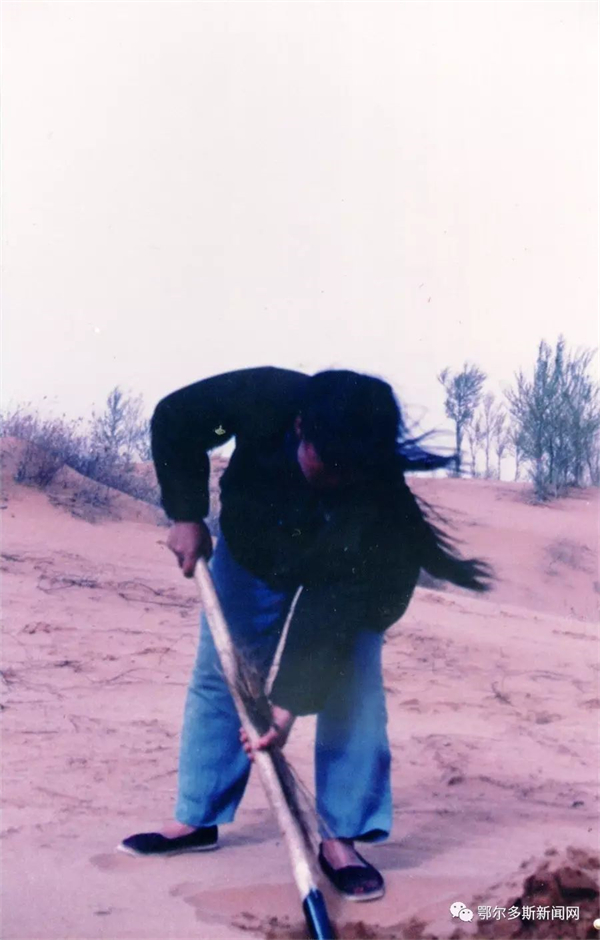The Mu Us Sandy Land, stretching across Shaanxi province, Inner Mongolia autonomous region, and Ningxia Hui autonomous region, was once an endless sea of sand, devoid of vegetation and uninhabited. Located on the southern edge of the Mu Us Sandy Land, Jingbeitang in Salawusu village, Wudinghe town, Uxin Banner in Ordos, Inner Mongolia, suffered from sandstorms and harsh living conditions for years.
In 1985, Yin Yuzhen married into the village. Since then, relying on her strong will, she made up her mind to fight to the end against Mu Us Sandy Land, one of China's four major sandy areas. Over the past 39 years, she had persisted in afforestation and desertification efforts, eliminating 70,000 mu (4,666.67 hectares) of sandy area in the Mu Us Sandy Land and creating a sea of green and "green home" for the local people.

Yin Yuzhen removes branches from a pine tree. [Photo/Ordos news network]
"I would rather plant trees to exhaustion than let sand bully me to death," said Yin, who did as she pledged. That spring, she brought around 50 saplings from her mother's home and planted them in front of her house. However, under the strong wind and sand, only two trees grew any leaves. Despite this, she planted hundreds of saplings that autumn, which cost a three legged goat – the only property her family owned. The following spring, more than 100 small trees sprouted fresh green buds, and the scene of green vitality blooming in the yellow sand sea gave her hope.

Yin Yuzhen in her youth. [Photo/Ordos news network]
Since 1985, Yin has been engaged in sand control and afforestation in the Mu Us Sandy Land for 39 years. Planting trees in sandy areas requires inserting steel drills into the sand and then planting seedlings that have been soaked in water. Over the years, she has worn out four steel drills.
Long-term heavy physical labor, unforgiving sandstorms, and the scorching sun, have left her with facial wrinkles, cracked skin, and callused hands, but she remained steadfast in her determination to control desertification and afforestation.
Without any form of transport, she would carry the saplings herself; without a source of water along the way, she planted apricot trees; if it was too dark to work, she slept in the desert and woke up in the early morning to continue working; and without a punching machine, she would drill holes with a steel drill.
Throughout the decades, Yin's husband Bai Wanxiang followed her without complaint and threw himself into the work. She feels that she is not a good mother and has neglected caring for her four children. In order to plant trees, she has been bringing her eldest son Bai Guolin into the sandy sea with her since he was one month old. Her youngest son Bai Guocai was mostly taken care of by Yin's mother. Recalling all those nights when he missed his mother, the 22-year-old boy stated, "She shares her love for me with that sapling, because the sapling is also her child."

Yin Yuzhen carries a large bundle of saplings. [Photo/Ordos news network]
Day after day, year after year, greenery gradually seeps into the sandy sea. The poplar trees planted by Yin in the early days have now become dense forests. In 2005, she established Inner Mongolia Oasis Sand Control and Afforestation Co, which planted crops such as millet, black wolfberry, and roses in sandy areas and started cattle and sheep farming.
After 39 years of hard work, Yin has controlled 70,000 mu of sandy area. Jingbeitang is now covered with green vegetation and has become home to orchards and new houses.
Sand control and afforestation not only changed the life of Yin and her family, but also inspired local villagers to embark on the path to wealth and prosperity by planting crops.